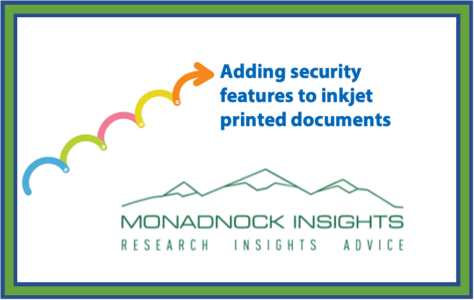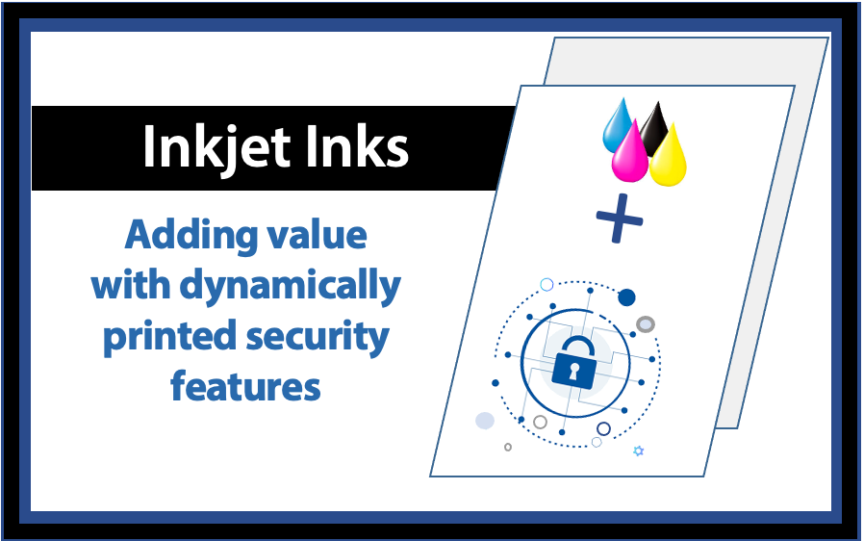The secure packaging, labeling, and documents market is growing, driven by retail, manufacturing, and pharmaceutical product integrity and tracking needs. Inkjet technology is one of several tools required to meet your client’s needs. Our five implementation steps will accelerate your security print offering.
Analysis
Printing of checks and other documents with security elements has existed for decades. Lucy Perez-Sierra, Senior Product Marketing Specialist with Canon Solutions America (CSA) notes the most common applications remain check printing, ballots, books, event tickets, passports and identity cards, prescription pads, and other legal and financial documents.
However, today’s market for printing with security features expands beyond documents to packaging and provides revenue opportunities for a wide range of commercial printing companies. Pharmaceutical companies must accurately track and trace medications from the factory to retailers and care facilities. Retailers must track their goods while easily determining whether a garment or sneaker, say, are counterfeit. Event organizers must know whether ticket holders have legitimate passes. Heavy equipment manufacturers, who store spare parts for years, must track the pieces and determine whether an illicit copy was substituted with potentially catastrophic results.
Brigette Wyatt, Business Development Manager for Kao Collin’s Advanced Printing Solutions unit, says the company is experiencing a growing demand for printed products with multiple unique security features used in supply chain applications. While off-the-shelf, UV-compatible inks are still widely used, clients are moving into “invisible” inks that are infrared compatible. Kao Collins is vendor agnostic, partnering with every printhead manufacturer, enabling it to develop proprietary inks for its printing company customers.
Insight
Printing with security features is more involved than replacing one ink with another. As John Hattersley, president of InData Systems, a manufacturer of specialty scanning equipment used in the tracking of covert marked products, put it, “People in counterfeiting and illegal businesses are very clever and capable of copying a feature.” Hattersley, who has several fluorescent ink and IR ink barcode reader patents to his name, advocates printing multiple features. Hence, if one element is obliterated, another feature elsewhere on the product enables the detection of improper distribution or sales.
Inkjet presses and other digital printing technologies are at security printing’s core. Despite the disparate applications, the one common element to printing security features is product customization, often at the individual piece level. Software enables individualization and finished goods tracking. Inks produce unique images which may be seen or unseen by the human eye and scanners. Inkjet, toner, and liquid ink presses print security features on a broad range of paper, label, and package substrates.
As you can see, printed security features are one element of a tightly interlocked suite of attributes that ensures global brand and product integrity. CSA’s Perez-Sierra notes, “A tight connection of design software and security inks is necessary to ensure consistency, quality, and readability of the security printed feature.”
Printing with Security Features – Implementation Steps
Source: Monadnock Insights
Following these five steps will smooth the implementation or expansion of an integrated security printing offering at your organization:
- Ascertain the customer’s need — The range of possible security requirements is as broad as your customer base. Some clients will focus on brand integrity, going beyond the critical logo color requirements. Other clients will be tracking products from their origin, perhaps across an ocean, and are concerned about grey market diversion. In almost every case, a combination of overt and covert design elements will be printed.
- Understand security technologies — Digital hardware, software, and ink print technology providers have offerings that will meet your needs. Some technologies, available from Canon, HP, and others, are off-the-shelf products, while providers such as Kao Collins develop custom formulations based on your individual customer’s needs.
- Prepare for data sharing — As crucial as inks and substrates are, the data driving security features are equally important. The data enabling feature customization is driven by the customer, who may not understand what is required to print their orders. Once you have that sorted out, the data must be securely transmitted and stored at your site. The data is then integrated with the end users’ devices and the scanning and reading technology used to ensure print quality.
- Implement the necessary production processes — Not unlike the first time you installed a production inkjet or other digital press, printing with security features requires an end-to-end assessment of your digital and physical workflow. Remember to include the hand assembly work that may be needed to finish or package the finished product.
- Develop robust quality assurance practices — The very features that deter theft and counterfeiting also make it challenging to ensure the product leaving your facility is correct. In-line QA tools such as cameras and software to compare the data input to physical output from companies such as Hunkeler and Videk may be needed. Don’t hesitate to work with the ink, hardware, and materials suppliers who have security printing experience. For example, Kristin Albee, Global Commercial Marketing Manager, HP PageWide Industrial Presses, notes the company has a professional services organization to help customers integrate printing of security features into their operation.
Advice
As more organizations implement multiple security features on their documents and packaging, the printing companies who master secure feature production not only expand their print offerings but also lock-in clients who rely on high-quality, customized documents and packaging. You can further minimize the risk of a client shifting their business to a competitor by:
- Staying on top of technology developments that could enhance your customers’ product security features by monitoring trends in optically variable inks, thermochromatic inks, daylight fluorescent inks, and other security and copy prevention features
- Striving to thoroughly understand your customers’ supply chain and product integrity requirements by involving not only salespeople but also operations and IT management in security discussions with the client
- Providing customer support on security ink and substrate compatibility by understanding how government regulations such as the Food and Drug Administration’s Good Manufacturing Practices for pharmaceutical goods affect their products
- Creating or refining your security printing production process by involving ink, toner, printer, and substrate technology providers and their technical services personnel in its design, implementation, and start-up
The market for printed security features is broad and growing. Contact us for more in-depth market insight and personalized advice.


